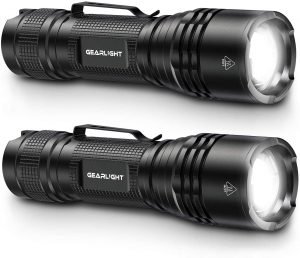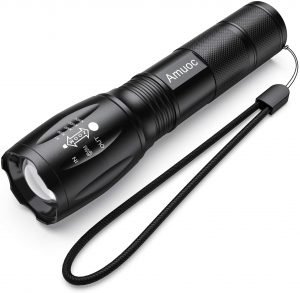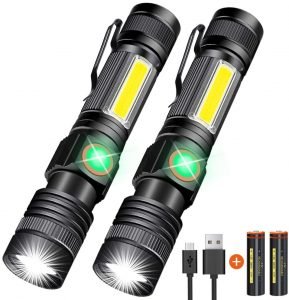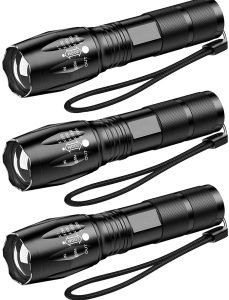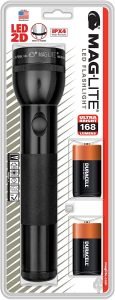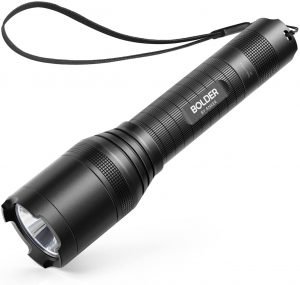As tech advances and becomes a more integral part of our lives, it’s easy to overlook simple tools such as the flashlight. But the flashlight has been an essential since humans discovered fire and made branches into torches. In British English, the word for a portable light is still “torch.”
Everyone should have a flashlight stashed at home and one in the glove compartment, at least. Many of you probably have an everyday carry flashlight as well.
Maybe you’re enthusiastic about outdoor pursuits, or you’re big on survivalism or everyday safety. But a flashlight is convenient in less pressing situations as well. The best camping flashlight will serve practically all your needs, minor to major. Here we will go over the key considerations when choosing a camping flashlight. For this article, we are not including headlamps, but are discussing flashlights specifically.
Key Features To Look For | Our Best Camping Flashlight Picks
Key Features To Look For In Camping Flashlights.
There are many features to check for when shopping for a flashlight: size, weight, brightness, and so on. Read on to get all the details.
Brightness
The standard unit of measure for brightness is the lumen. The higher the lumens, the brighter the light.
A good working range for your camping or everyday carry flashlight is 300–1,000 lumens. Anything lower is too dull to be useful. And believe it or not, a flashlight can be too bright, washing out the illuminated area and making it hard to see.
Apart from the lumens measurement, many everyday carry flashlights have adjustable brightness settings. These settings work much like your car’s headlights (although headlights vary in angle too, whereas flashlights typically don’t). A high beam from a flashlight isn’t only brighter than a low beam but also shines farther into the distance.
Keeping your flashlight on a lower setting as much as is reasonable saves power and extends the light’s runtime (see below). Save that high setting for when you really need it.
Size
Flashlights come in a huge range of sizes, from tiny keychain versions to flashlights more than a foot long. The size you choose depends on how often you’ll be using your flashlight and where you’ll keep it.
If you’re looking to carry your torch in a backpack, you probably want something small or mid-sized. If you’re stowing a flashlight in your camper or vehicle, then you can get away with a bigger item.
If you want to be able to use your flashlight as a weapon (more on this later), you’ll want a more massive light for sure.
Bigger flashlights tend to cost more, although it isn’t necessarily always the case.
Weight
Generally, the larger the flashlight, the heavier it is. Most flashlights are reasonably weighted. After all, a flashlight that’s too heavy to use effectively or comfortably defeats the purpose and becomes, well, a table lamp! But a flashlight you plan to carry on your person should be as lightweight as possible, for obvious reasons. You probably don’t want to go too far over one pound. Those looking to use this camping and may frequently carry this in a backpack will want lighter options, while those who will store in the car may not care much about the weight.
Power
You’re certainly familiar with battery-powered flashlights. You can also find solar-powered flashlights, shake flashlights, and rechargeable flashlights.
If you’re heading out on an excursion with a battery-run flashlight, always take more spare batteries than you think you’ll need. As soon as that first set wears down, you’ll be glad you planned ahead.
In an ideal world, solar flashlights would reign supreme. In the real world, they’re best used as backup flashlights. Your ability to charge a solar flashlight depends on the amount of environmental light available at a given time. That’s why these lights just aren’t reliable enough for primary use.
Like solar flashlights, shake flashlights are better reserved for secondary use. Believe it or not, shaking them gets old fast, especially if you’re using your light a lot. And these aren’t the brightest lights in the world, so they may not work great in emergency situations.
Rechargeable flashlights are great around the house. But because they require a charging cord, they’re not ideal for camping, hiking, and fishing—unless you’re going upscale at a site with electricity hookups. In fact, almost anytime you’re away from your home or office, you’ll want a portable flashlight that’s always ready to use.
With this being said, you simply should consider which type of flashlight best suits your needs. We tend to like battery powered flashlights and always carry extra batteries in case they are needed.
Runtime
By the time your flashlight’s brightness deteriorates to about 10%, it’s pretty much useless and needs a power refresh. The length of time it takes a flashlight to dull to this degree is called its “runtime.” At this point, you’ll want to replace your batteries, or give your Faraday flashlight (another name for the shake flashlight) a workout.
Runtime isn’t calculated from full brightness to 0% because by the time you’re in total darkness, you’re in trouble. Some lights fade over time, whereas others go dull quite quickly at the end of the runtime.
The longer the runtime, the better off you are. You may have to sacrifice size or weight for a longer runtime. Also look for flashlights that have multiple settings. Many lights will have a low setting that lasts 15 hours, while a higher setting may last only 6 hours. We love flashlights with multiple settings so that you can use low modes for the most part, until you really need that extra brightness. This will extend your usable runtime.
Miscellaneous
In addition to the above, you may want to consider the durability of a flashlight as well as its grip and even its color.
You can also find flashlights with a variety of extra features, such as
- Strobe mode
- Red light
- Zoom function
- Stun gun or taser function
- Morse code button
And many flashlights come with accessories such as straps, belt clips, and holsters.
New multipurpose tools are always popping up on the market. Sit down and make a wish list of all the features you might be interested in having combined with your flashlight. Then get about searching. You’re more likely than ever to find just what you’re looking for.
Other Ways to Use a Camping Flashlight
Here are some other surprising reasons to carry a flashlight instead of relying on your phone.
You Can Use Your Flashlight for Self-Defense.
Aiming a bright light in the eyes of a person or animal can stun them for a moment, buying you some time. The light may even be enough to scare some attackers away. You can also use your light to administer blunt force if you’re close enough.
Your Flashlight Is a Multipurpose Tool.
More than light, a flashlight can come in handy in other emergencies. A sturdy light can be used to break glass, crack ice, or open nuts as a last resort. Just be sure the situation at hand is worth risking a broken flashlight.
You can also use your light as a beacon or to signal someone in Morse. As mentioned above, some flashlights come with a built-in Morse function.
Larger flashlights can also be used as self defense tools, much like a baton. A metal flashlight with some weight behind it can be a great defensive tool.
What’s Are The Best Camping Flashlights?
There’s no one-size-fits-all recommendation when it comes to the best camping flashlight.
With this being said, we have listed some of our personal favorites, as well as those that contain key features, and have incredibly good review ratings from other users.
E300 EDC Tactical Flashlight

EDC Tactical Flashlight
But the battery-powered E300 EDC Tactical Flashlight is a strong option. The E300 offers 300 lumens, three modes (high, low, and strobe), and a zoom lens.
The strobe light comes in handy during emergencies, as it blinks to draw attention to your location and serves as a distress signal. The zoom feature lets you focus all the light on a target.
The E300 features a long-running LED and anodized aluminum housing. This rugged flashlight is water-resistant, shockproof, and anti-abrasive. It’s a great choice for almost any application.
GearLight LED Flashlights S1050

GearLight LED Flashlights for Camping
Key Features:
- Wide to narrow zoom on light for multiple functions and purposes
- Runtime of 10+ hours
- Multiple light settings
- Multiple battery types can be used on this light
Vont ‘Blaze’ Tactical Camping Flashlight

Vont ‘Blaze’ Tactical Camping Flashlight
Key Features:
- Extremely durable, able to hold up to freezing temperatures, and even submerging under water
- Extremely Lightweight
- Multiple Lumens settings
- Zoom in and out functionality
- Lifetime warranty
GearLight Tac LED Tactical Flashlight
Key Features:
- Belt clip for easy attaching to clothing
- One light mode for easy on off, but multiple zoom options
- Multiple battery types can be used on this light
- IPX4 water rated, and shockproof
Amuoc LED Tactical Camping Flashlight
Key Features:
- Multiple light settings including SOS and strobe settings
- Multiple zoom options for narrow or wide beam
- Waterproof and “explosion proof”
- 1000 lumens
- Very small design
Hoxida USB Rechargeable Camping Flashlight
Key Features:
- Rechargeable batteries
- Multiple zooms and light settings
- Magnet to attach to metal surfaces
- Waterproof
Modaau Ultra-Bright Flashlights, 2000 Lumens
Key Features:
- Multiple settings for amount of light
- Different zoom settings
- Can take multiple battery types
- Water resistant and shock resistant
- Very small design. Can easily fit in pocket.
Maglite LED 2-Cell D Flashlight, Black
If you are camping out near your call all the time, we love to recommend the much larger and heavier Maglites.
- Can be used for self defense
- Weather, water, and drop resistant
- Lifetime warranty
- Can also purchase a larger 3-cell version
Anker Rechargeable Bolder LC90 LED Flashlight
Key Features:
- 900 Lumens
- 6 hours of runtime on rechargeable batteries
- 18 month warranty
- IPX5 water rates
- Small enough to fit in your pocket
Conclusion
You don’t have to love hiking and fishing to add an everyday carry flashlight to your arsenal. Even if you’re a city slicker or a diehard minimalist, a good flashlight is a must-have. It’s one of those things you won’t miss until you desperately need it. Do yourself a favor and be prepared.
Max DesMarais is the founder of hikingandfishing.com. He has a passion for the outdoors and making outdoor education and adventure more accessible. Max is a published author for various outdoor adventure, travel, and marketing websites. He is an experienced hiker, backpacker, fly fisherman, backcountry skier, trail runner, and spends his free time in the outdoors. These adventures allow him to test gear, learn new skills, and experience new places so that he can educate others. Max grew up hiking all around New Hampshire and New England. He became obsessed with the New Hampshire mountains, and the NH 48, where he guided hikes and trail runs in the White Mountains. Since moving out west, Max has continued climbed all of the Colorado 14ers, is always testing gear, learning skills, gaining experience, and building his endurance for outdoor sports. You can read more about his experience here: hikingandfishing/about

